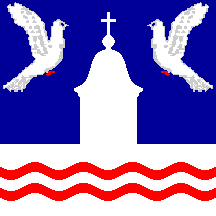
by Zeljko Heimer , 21 June 1999

Last modified: 2003-07-05 by dov gutterman
Keywords: bosnia and herzegovina | bijeljina | republika-srpska | semberia | drina | sava | belltower | dove |
Links: FOTW homepage |
search |
disclaimer and copyright |
write us |
mirrors

by Zeljko Heimer , 21 June 1999
See also:
I saw on TV a blue over white flag (3:2). In the base of the
blue part is a "house" (perhaps eglise) coroned with a
cross. In the white part are two red wavy lines. The flag was on
a wall of a serbian church (inside the church).
Jaume Olle', 10 April 1998
bn.gif)
by Zeljko Heimer , 21 June 1999
Few days ago I received the image of CoA of Bijeljina, city in
north-eastern corner of B&H and community of the same name
(whose CoA that is, I belive, rather then of the city itself, but
it makes little difference). The community covers the region
called Semberia, at the confluance of Drina river into Sava. The
CoA is take from a postcard issued in 1997, and its overall
layout looks like the modern CoA adopted in Serbia recently,
probably designed by the Serb Heraldic Society.
The CoA may be blazoned: Azure, a belltower Argent with two doves
flying in cantons towards it, base Argent a tau-cross Gules.
Crowned with mular crown with facade Or. Compartment Vert bearing
white ribbon with name in cyrillic, and maize and corn Or.
Supporters: dexter old man in national costume with
"gusle" holding banner of Serbia (Republika srpska,
that is), sinister a merchant in rich clotes with bag of money
holding the banner of Bijeljina. Banner of arms is the same as
shield, with the tau-cross changed into two wavy bars Gules. Both
banners have finials golden doves. The belltower is said to be
the tower on the city hall. The "tau-cross" probably
represents confluence of drina into Sava ("theory"
further supported by changing it to wavy bars on the banner). The
old man holds "gusle", one string instrument typical
for Serb folklore. The merchant (if it is one) is wearing clotes
of rich dignitaries of beggining of 18th century. Maize and corn
represents main agricultural products of the region.
Zeljko Heimer, 21 June 1999
It was designed by the Serbian Heraldic Society.
Ivan Sarajcic , 29 May 2000